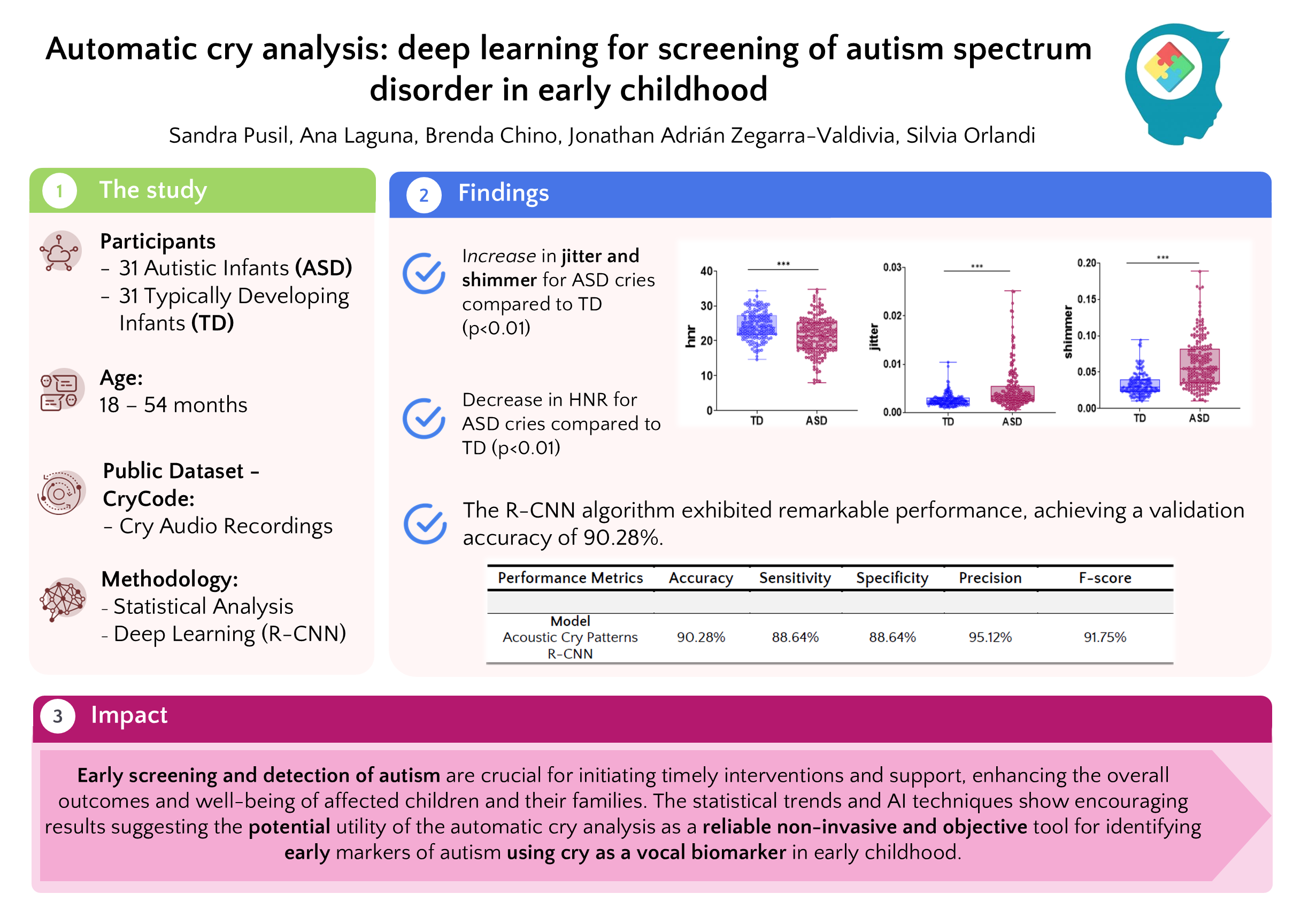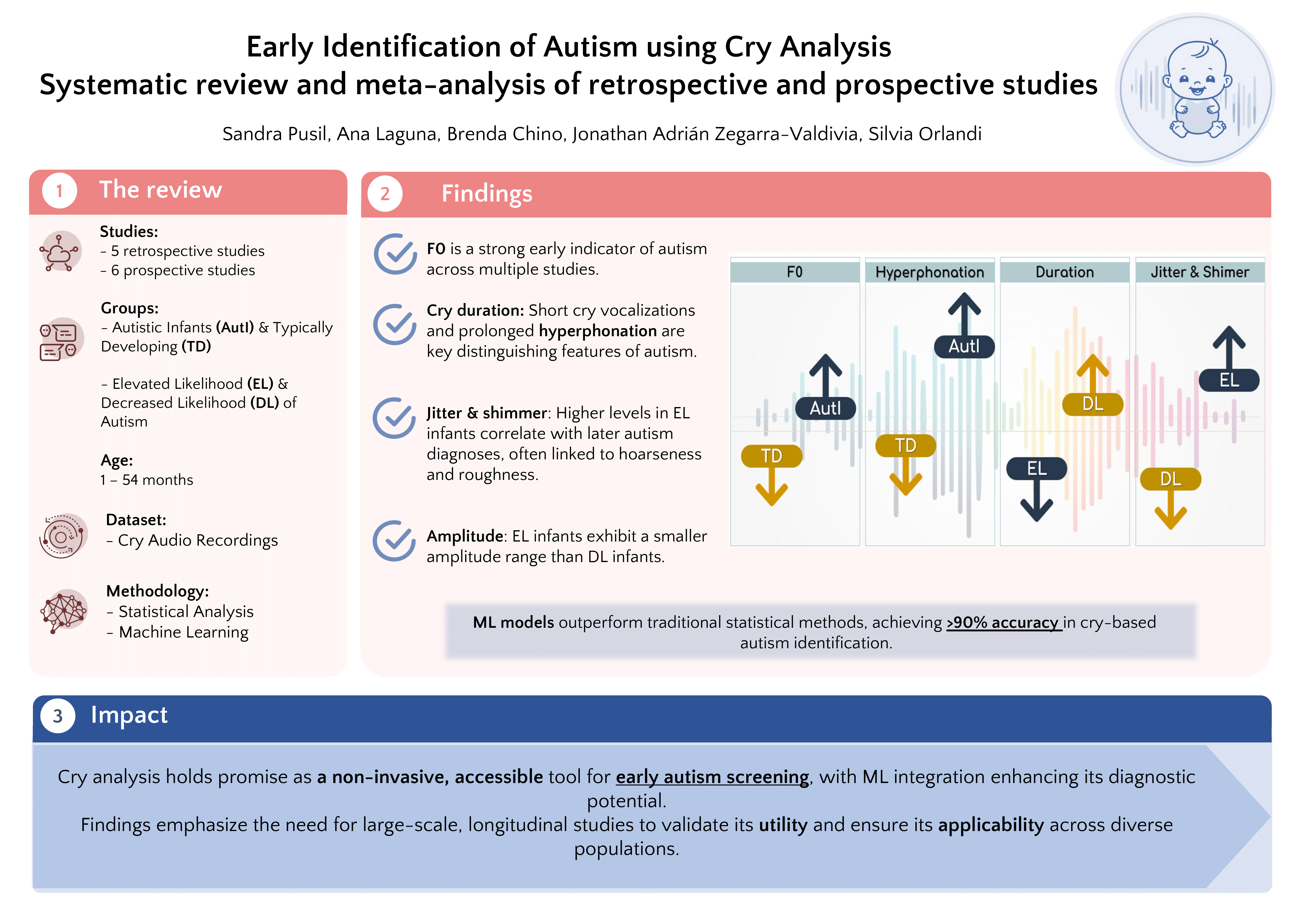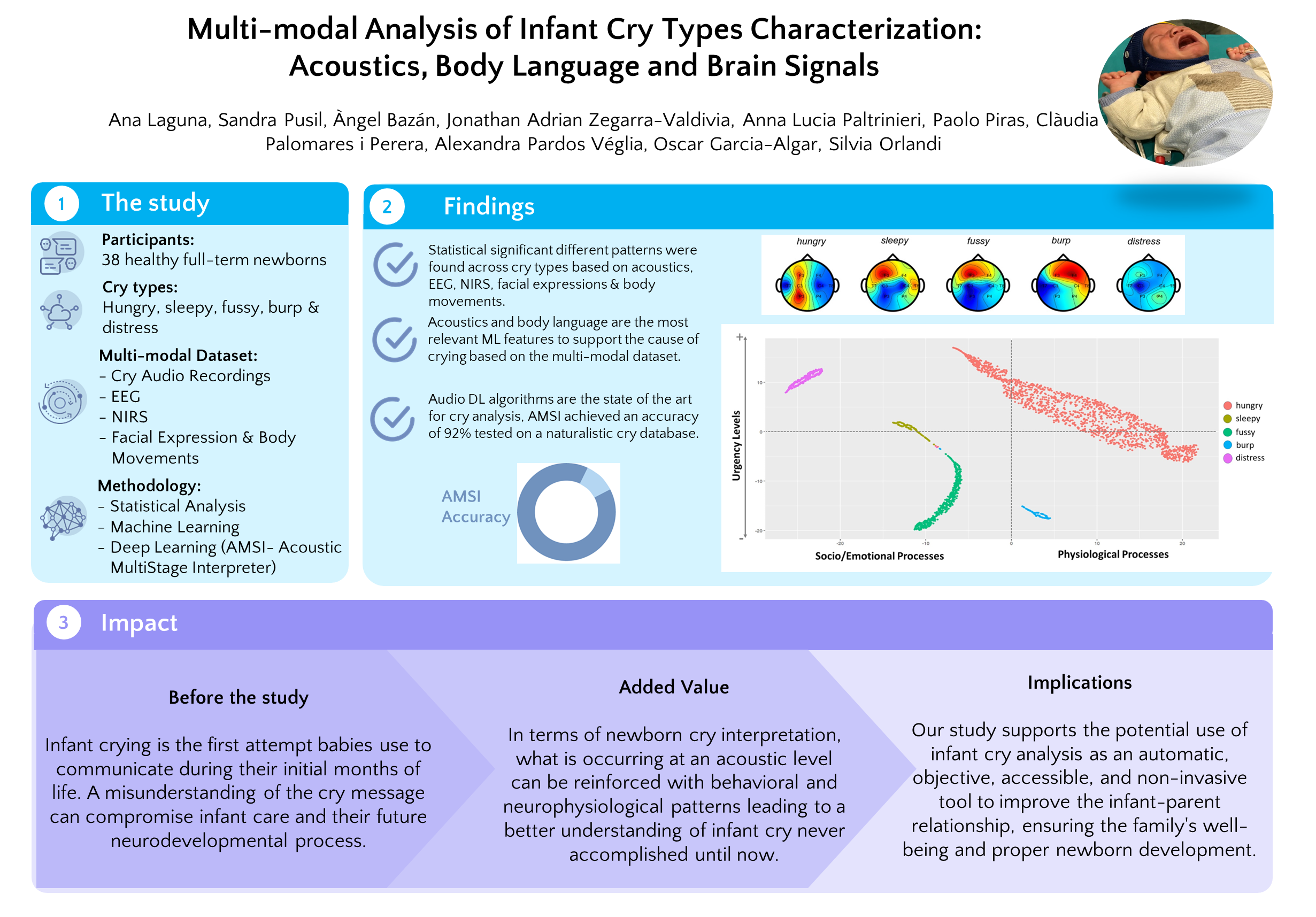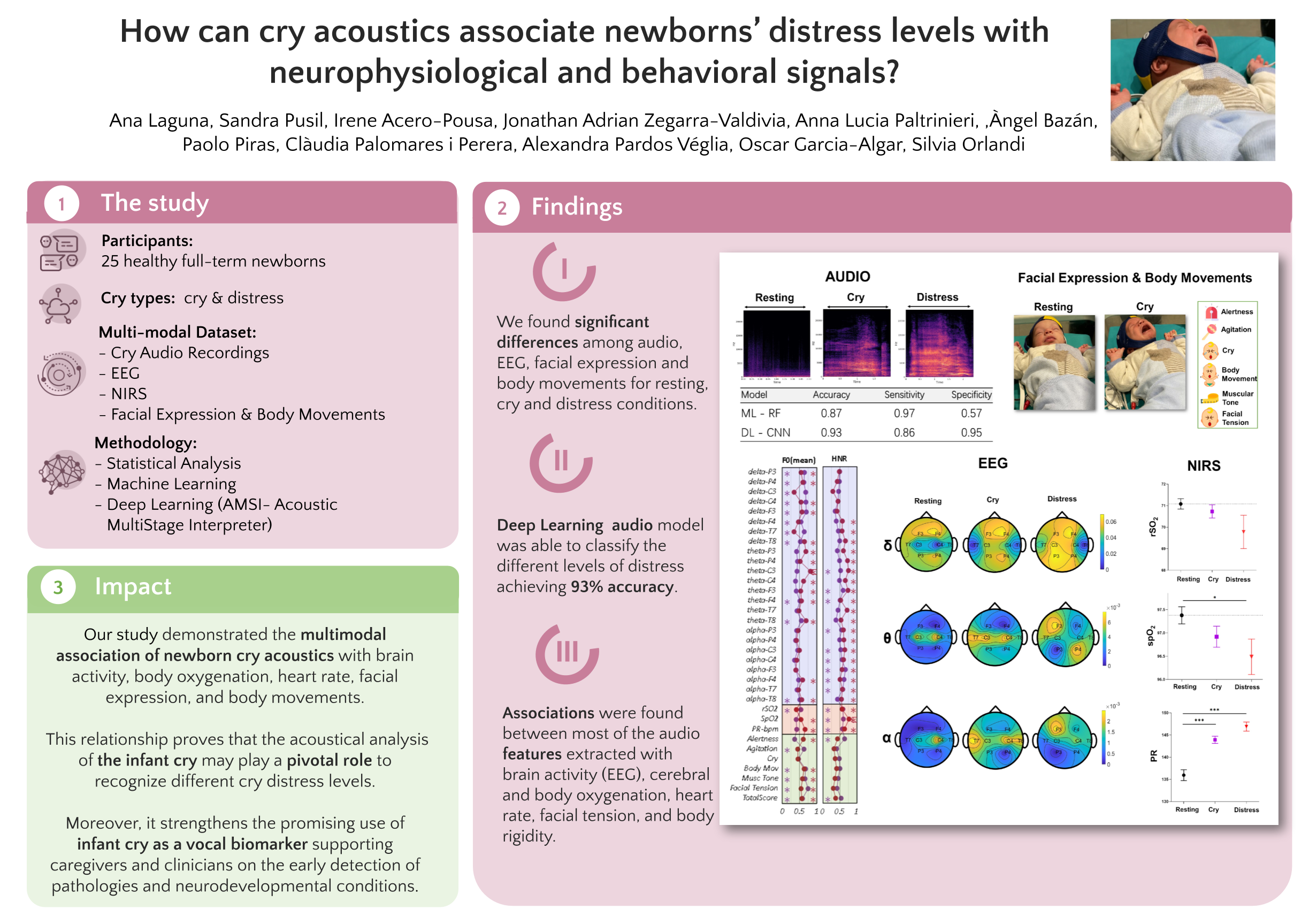Zoundream's AI-Based Cry Analysis: A Breakthrough in Infant Care and Family Well-being.
Zoundream technology has been built based on over five years of research, in collaboration with pediatricians, clinical researchers, and hospitals around the world.
The technology has been used by thousands of families with their babies, for over a milion hours of use, inside families' homes.
The collaboration with some hospitals also led to some scientific papers being published on top tier clinical journals. An extract (and link to full articles) can be found below:
These findings will contribute to a better understanding of the interpretation of cry never accomplished until now, emphasizing the clinical potential of cry analysis as an objective non-invasive AI-based tool to enhance the parent-child relationship and ensure family well-being and the proper development of the newborn.
Scientific Journal Publications:
Automatic Cry Analysis: Deep Learning for Screening of Autism Spectrum Disorder in Early Childhood
The objective of this study was to identify the acoustic characteristics of cries from Typically Developing (TD) children and those with Autism Spectrum Disorder (ASD), using Deep Learning (DL) techniques to support clinicians in early detection efforts. We analyzed an existing cry dataset including 31 children with ASD and 31 TD children aged between 18 and 54 months.
Statistical analyses revealed significant differences between the two groups in several acoustic features: cries from children with ASD exhibited higher jitter and shimmer values, and lower Harmonics-to-Noise Ratio (HNR). A Deep Learning model based on Recursive Convolutional Neural Networks (R-CNN) was developed to classify cries, achieving an accuracy of 90.28% in distinguishing ASD from TD.
This research highlights the potential of non-invasive, AI-based tools leveraging cry vocal biomarkers to empower earlier clinical decisions and interventions. It represents a crucial step toward our mission: transforming infant cry analysis into a powerful instrument for accessible and scalable early screening.
Early Identification of Autism Using Cry Analysis: A Systematic Review and Meta-Analysis
This groundbreaking study explores the potential of infant cry analysis as an early vocal biomarker for Autism. By systematically reviewing and analyzing existing research, we examined how acoustic features—such as fundamental frequency (F0), cry duration, jitter and shimmer—differ between autistic and typically developing infants. Machine Learning models played a crucial role, uncovering subtle patterns in cry characteristics that traditional methods might miss.
Results highlight a consistent trend of acoustic differences in cries associated with autism, with ML-driven analysis significantly enhancing screening precision. Although further large-scale validation is needed, this study lays the scientific foundation for integrating AI-based cry analysis into early autism identification. These findings mark a pivotal step toward developing non-invasive, objective tools to support families and healthcare professionals, ensuring early intervention and improved developmental outcomes for infants.
Multi modal Analysis of Infant Cry Types Characterization: Acoustics, Body Language and Brain Signals
This pioneer study examines a multi-modal approach to characterizing infant cry types, utilizing acoustics, body language, and neurophysiological signals like EEG and NIRS. The study collected a realistic dataset from 38 healthy newborns at Hospital Clínic (Barcelona, Spain)under infant’s spontaneous conditions. Machine Learning models, including a specialized Acoustic MultiStage Interpreter (AMSI), were applied to classify cry types.
Results indicated significant differences in cry characteristics across types, with features from acoustics and body language emerging as the most informative for cry classification. The AMSI algorithm achieved a 92% accuracy classifying hunger, sleepiness, fussiness, need to burp and distress.These findings will contribute to a better understanding of the interpretation of cry never accomplished until now, emphasizing the potential of cry analysis to enhance the parent-child relationship and ensure family well-being and the proper development of the newborn.
How can cry acoustics associate newborns’ distress levels with neurophysiological and behavioral signals?
In this innovative research, conducted through a clinical study at Hospital Clínic (Barcelona, Spain), we used for the first time cry audio analysis as a prospective vocal biomarker of newborns' distress states cross-validated with behavioral and brain signals. Data from 25 healthy full-term newborns, including cry acoustics, EEG, NIRS, and video recordings, were analyzed across resting, cry, and distress conditions. The study developed a Deep Learning algorithm that achieved a 93% accuracy in classifying distress levels based on audio features.
Findings indicate that cry features such as pitch and intensity correlate with neurophysiological signals, highlighting infant crying as a potential biomarker of distress quantitatively supporting the assessment of the arousal state of the infant in the future neonatology.
Scientific Conferences:
Quantitative Analysis of Cry Acoustics and Neurophysiological Signals for Assessing the Infant Health Status
This poster presented at the 14th International Newborn Brain Conference in Cork in February 2024 examines the use of cry acoustics and neurophysiological signals as indicators of infant health, aiming to establish cry analysis as a non-invasive biomarker for early neurological assessment.
Data from three groups: full-term, extremely premature, and infants with brain injuries was collected from spontaneous cries and neurophysiological recordings at Hospital Clínic (Barcelona, Spain). Cry acoustic features (e.g., jitter, shimmer, and noise) and brain wave patterns (delta and theta bands) were analyzed, revealing significant differences across the groups. Pathological infants exhibited elevated jitter and shimmer levels, while neurophysiological analyses indicated decreased delta and increased theta band power among infants with brain injuries.
Automatic Detection of Pathological Signs in Newborns Through AI and Cry Analysis for Assessing Infant Health Status
Our latest research presented at the European Academic of Pediatric Societies in Vienna in October 2024 explores the development of an AI-driven tool for the early identification of health conditions in newborns through cry analysis. Traditional assessments of newborn cries, used to detect neurological issues, pain, or discomfort, rely heavily on subjective expertise. This study aimed to create an objective, AI-based algorithm to differentiate between the cries of healthy newborns and those with pathological conditions.
A cry dataset was collected from 58 newborns at Hospital Clínic (Barcelona, Spain), consisting of both healthy and pathological newborns (infection, gastrointestinal, respiratory, etc.). Using a gradient-boosted decision tree model, the algorithm achieved a 94% accuracy in distinguishing between the two groups. Key distinguishing cry features included voice quality, energy, and vocal tract physiological factors.The study demonstrates the potential of cry analysis as a non-invasive, objective tool for early diagnosis, offering significant value in clinical neonatal assessments.






